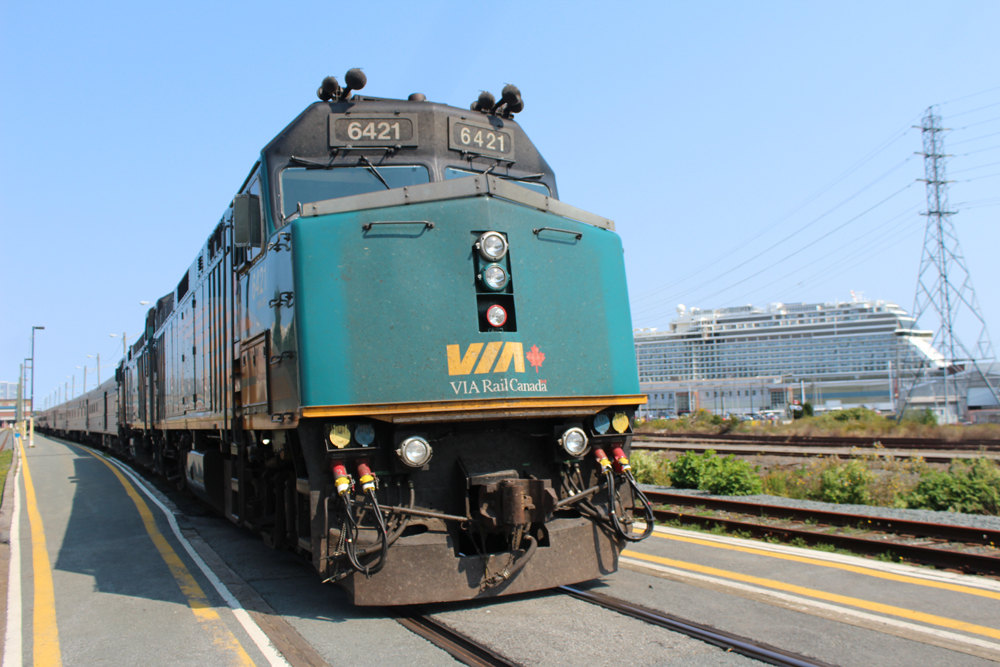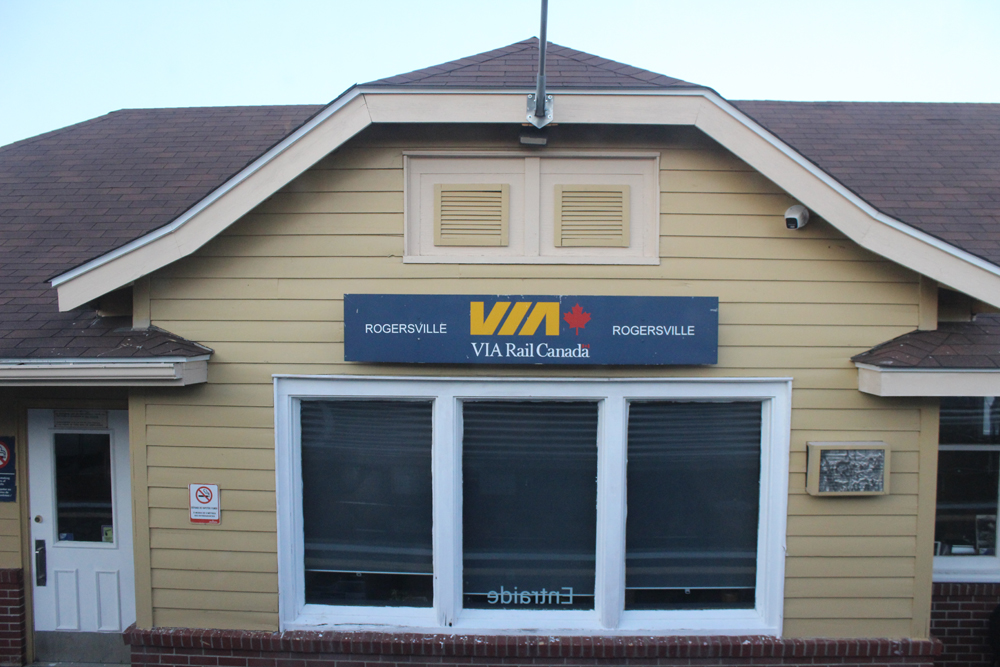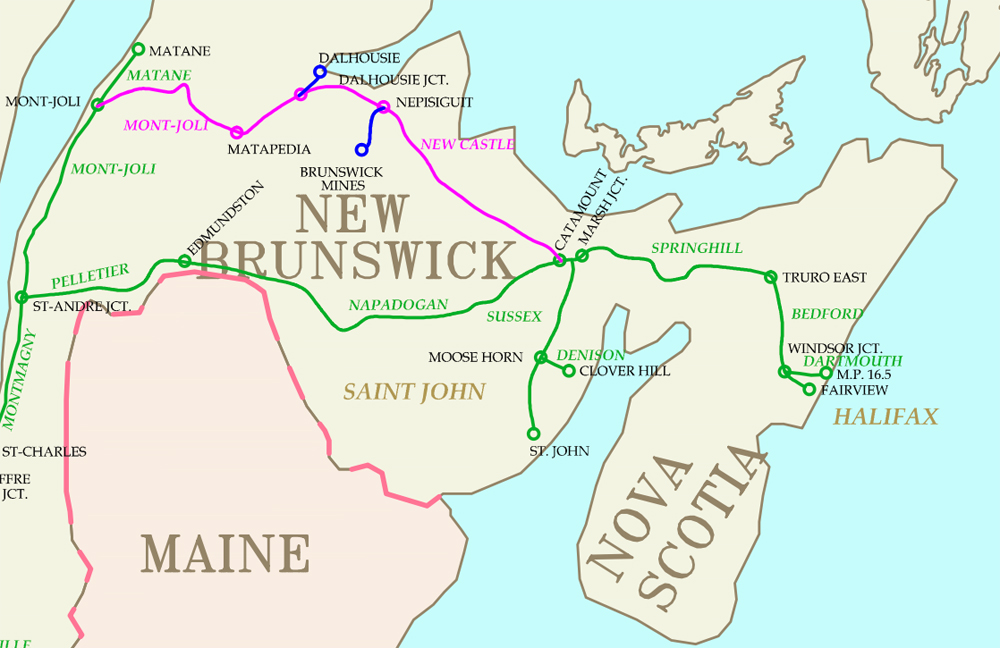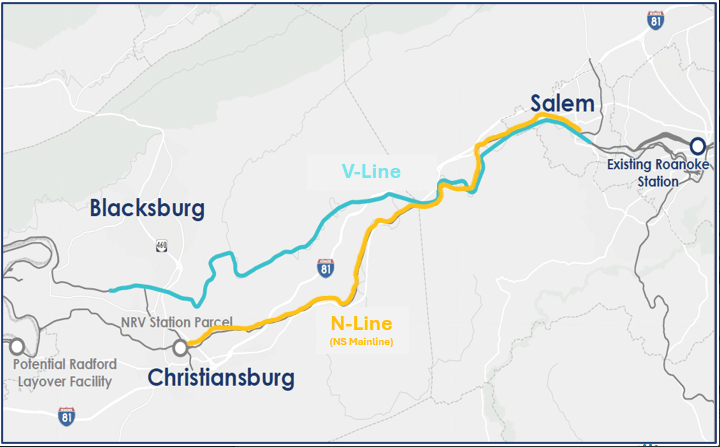
MONTREAL — Beginning June 19, VIA Rail Canada is adding 90 minutes to the westbound schedule of its Montreal-Halifax, N.S. Ocean and 45 minutes to the eastbound train, “to provide passengers with a schedule which better reflects actual travel times,” according to a statement provided by VIA in response to a set of detailed questions News Wire emailed last week.
The reason for the slowdown is numerous slow orders Canadian National has begun imposing primarily on 187 miles of track between Moncton and Campbellton, New Brunswick, that also only hosts local CN freight traffic.
A comparison of old and new timings is available on VIA’s website — the eastbound schedule is here, while westbound is here.
The westbound triweekly Ocean now departs Halifax at 11:30 a.m. instead of 1 p.m., but arrives at Montreal’s Central Station at 9:53 a.m. the following morning, as scheduled previously. The eastbound train leaves Montreal 30 minutes earlier at 6:30 p.m. and arrives 15 minutes later at 6:06 p.m.
Because Canadian National has, for more than a decade, diverted most through freight between Quebec and Atlantic Canada on a more direct but lightly populated route skirting the Maine-Canada border, the railroad has demanded that VIA pay for additional maintenance to achieve passenger train speeds. If the money is not forthcoming and trackwork is deferred, the result is an unresolved dispute between the parties. The potential impact of slow orders on the route’s relevance is ignored by funders and operators, and the traveling public suffers.
A similar scenario has played out between CN and Amtrak over the Canadian portion of the New York-Montreal Adirondack, a train now is set to be sidelined north of Saratoga Springs, N.Y., until the busy summer travel season is over [see “Suspension of Amtrak’s Adirondack to Montreal will continue into September,” News Wire, June 7, 2024].
Canadian National had previously leased the Moncton-Campbellton segment to a short line and threatened outright abandonment in 2014 unless public funding was forthcoming. At the time, New Brunswick’s government agreed to provide some money, but only for freight customers; VIA provided C$18.3 million to CN for repairs between Bathurst and Miramichi, N.B, the portion of the route that New Brunswick wouldn’t cover.
“Unfortunately,” VIA says in a statement to News Wire, “the current conditions of that same infrastructure have now led to some operational changes. In response to recurring slow orders imposed by CN, along with a deterioration of operational speeds on that infrastructure due to track conditions, notably on the Newcastle subdivision, VIA Rail has no choice but to adjust the schedule of the Ocean.”
The lengthy statement adds, “VIA Rail remains strongly committed to offering its passenger rail services on the Ocean route between Montréal and Halifax. Since the vast majority of tracks between Montréal and Halifax are owned by CN, VIA Rail is subject to CN’s constraints and challenges when operating the Ocean route, pending CN’s capacity to resolve any issues.”
Asked about specifics, VIA says, “As we are not responsible for the level of upkeep of the track, we have no authority to answer questions on the condition of the tracks, the evolution of operational speeds over the past years, the nature and results of the work and maintenance done on the infrastructure or any other information pertaining to the railway infrastructure they own.”

Among the questions News Wire asked of both VIA and CN:
— Are the speed restrictions heat related?
— Are there speed restrictions below the Class 2 speed limit (30 mph) for passenger trains? (A 2016 employee timetable showed maximum speeds of 30 mph for passenger trains on a 59.2-mile section of the Newcastle Subdivision from milepost 48.4, near Rogersville, N.B., to MP 107.6, near Nepisguit, N.B.)
— Approximately how many miles of slow orders are involved?
— Has a price been quoted for track investment to raise speeds to at least 60 mph, and if so, what is the amount?
Canadian National spokeswoman Ashley Michnowski did respond to News Wire with this statement:
“Safety is a core priority at CN. Speed restrictions are implemented and modified as necessary to ensure the safe operation of the railway. Work is ongoing on the Newcastle Subdivision to increase speeds. CN’s ongoing maintenance of the Newcastle Subdivision will allow for some improvement to speed restrictions in the coming weeks and months. Last year, CN made roughly $22 million in capital investments to maintain nearly 600 route miles of track in New Brunswick, including on the Newcastle Subdivision. Maintenance work occurs regularly across our network, to the extent it is commercially reasonable.”
What is “commercially reasonable?” The trade-off between investment cost and speed achieved. Determination of that point is known only to VIA and Canadian National, as is the operating agreement between the two parties that the public is paying for. Both operator and railroad regard all contracts as too “commercially sensitive” to be divulged, even though public funding and mobility that is at stake.















Maybe it’s time to resurrect the Atlantic, extending it from St John to Halifax.
Has the advantage of serving both maritime cities.
Let’s remember that the VIA’s hapless OCEAN is the oldest continuously operated named passenger train in North America.
Dr. Güntürk Üstün
Considering that the eastbound Ocean routinely runs up to two hours late — as I wrote this, today’s train was scheduled into Halifax Station 100 minutes off the advertised — it would seem that Via’s new schedule is set up to fail. With this latest change, a trip by rail between Montreal and Halifax will now take a minimum of 23 hours and six minutes (eastbound), three hours and 24 minutes more than in 1994 and two hours and 24 minutes more than in 1964. All this for a base economy fare of $255 or $426 for an undiscounted Renaissance cabin.
No surprise being CN. If the route isn’t worth investing in then sell it, but no instead they try & squeeze money out of Fed or Prov govt. Why not just be up front & offer to work on the issue with all the concerned parties to maintain the route for the benefit of all the customers freight or psgr, but no just more of the typical RR passive aggressive, sh***y attitude to all including their customers.
“Commercially viable” should be what kind of service the customers DEMAND, not request…customers keep letting the railroads browbeat them. Either that or CN should just let a shortline/regional run the entire route that includes the Newcastle Subdivision…they obviously don’t want the freight traffic.
Seems to me, VIA has a few choices here:
1. continue as is, understanding the trains may be moving at Canadian Class 1 (15 mph) at some time.
2. buy the RR from CN (or have the Provinces do it) and maintain it for passenger trains (Class 3 = 60 mph)
3. substitute daily bus service for the train, possibly with an overnight hotel stay.
4. use CN’s freight route and give up service to the current intermediate stations
More zombie trackage; former ATSF across Kansas, more former ATSF over Raton, former ACL between DeLand and Palatka, Florida, former NYC across Michigan, etc. But for a passenger train these rails would have disappeared. Asking the railroad to keep them is charity. Asking the railroad to keep them maintained to passenger speeds is extortion.
I see your point Daniel about zombie routes used by passenger trains. All I can say is that the ones I’m familiar with (ATSF, Michigan Central) used to be freight routes, long ago. When I was a student at U-Michigan 1968 – 1970, I saw lots of Penn Central freights (heavy with CP Rail freight cars) rolling through Ann Arbor.
Point not taken…with all the cutbacks in rail route mileage sometimes, these “passenger only” routes as you call them, are the viable alternatives during extreme maintenance blitz, weather related closures or other reasons for needing a rerouting of freight traffic. There’s a reason the trucking industry eats the railroads lunch on long haul freight and it’s not all related to pricing. Guarantee the railroads could haul more general freight at higher rates with CONSISTENT service dock to dock, and that is only achievable with multiple routings at higher speeds(and shorter trains, but that’s a different subject). I really need to model this in a computer program…
How old am I that I remember stuff from half a century ago but am confused as to today’s date. October 1974 Passenger Train Journal, an article about how Canada’s passenger train network rivaled that of America, a country with ten times Canada’s population. That was then and this is now. Now, VIA is a rolling trainwreck, to mix a few metaphors. Compare early VIA timetables to what little is left now, it’s disgusting.
Perhaps the Stalinist government of Justin Castreau (the next election can’t come soon enough) should maybe do something about it.
Oh, to respond to my own post, let me ask this. How many train pairs does VIA have in the Maritimes? The Ocean runs triweekly. I believe (I may be wrong) all other VIA trains have been cancelled. So if I’m correct, that means Canada has more Maritime proviinces (four) than VIA has Maritime train pairs in a week (three).
The biggest problem with the Ocean isn’t an extra hour of padding in the schedule. The biggest problem is that it runs triweekly. What’s another hour if you have to wait two or three days for a train.
There are not four Maritime provinces; there are three, and only two of them have rails.
I am not sure what your point is. The current government has spent almost $1 billion re-equipping Via’s corridor fleet, has started procurement on high-frequency rail, estimated at up to $12 billion, and included procurement for new long-distance equipment in last April’s budget. This compares to the prior Harper/Poilievre government’s commitment to passenger rail of…hmm…exactly zero dollars. But we can only assume that, as an valiant commie-fighter, your preference is to do nothing whatsoever about it.